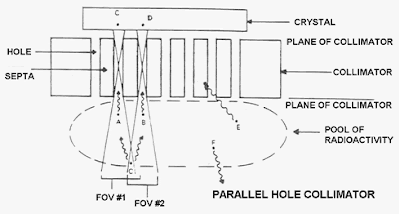 |
| Fig. 1 Coronal CT image. Note the "inverted Y" shaped tissues just above the kidneys. This is what typical adrenal glands look like on CT. Click on the link for more in depth information. |
 |
| Fig. 2 Same section of the coronal plane corresponding to the previous CT. Note the F18 FDG uptake above the renal poles, midline to the body. |
 |
| Fig. 3 Fused CT and PET image of the two images. Note the metabolically active regions above the poles of the kidney, midline to the body. Expand the image to get a closer look. |
Generally, PET/CT requisitions must be approved by our physicians and they have to follow certain guidelines for approval as set out by local government who sponsors some of the costs. However some patients do not fall within these guidelines and as the result they must go through another route. Well this is one of those patients that have gone through this "other" route to have their scan.
The case history is interesting. Originally the patient presented with fatigue and proximal leg weakness with a long history of hypertension and dyslipidemia. However, recently the hypertension has been uncontrollable and had developed hypokalemia, weight gain, bruising, and diabetes. Blood work was also performed to correlate these findings (dexamethasone suppression test). To make a long story short, they suspected that Cushing's Syndrome may be the cause.
Cushing's Syndrome tends to be rare often affecting maybe 2 to 4 cases per million inhabitants per year. The problem with this condition is that, there is too much glucocorticoids being produced by the adrenal glands (adrenal cortex), in particular cortisol. Cortisol affects the body's pathways in the following:
1. Stimulates gluconeogenesis in the liver
2. Mobilization of amino acids from extra hepatic tissues to act as substrates for gluconeogenesis
3. Inhibition of glucose uptake in muscle and adipose tissue to allow for glucose conservation
4. Stimulation of fat breakdown from adipose tissue. Basically the fatty acids are used for energy production in tissue (muscle) and the glycerols from the fat are used for other substrates for gluconeogenesis
The glucocorticoids have an immune and anti inflammatory response as well, often given in therapeutic doses to treat arthritis and dermatitis.
So how do you produce too much glucocorticoids? There are a couple of ways:
1. The negative feedback loop among the hypothalamus, pituitary gland and the adrenal glands do not work. Basically there is too much adrenocorticotropic hormone (ACTH) being produced by the pituitary thus influencing the adrenal glands to produce more glucorticoids
2. There is/are tumour(s) within the adrenal glands
3. There is/are ectopic tumour(s) elsewhere in the body producing cortisol
4. There is/are ectopic tumour(s) elsewhere in the body producing ACTH
Getting back to this case, the patient had a "radiological work up" to figure out what was wrong. The ultrasounds did not give any indication of any tumours in the adrenals but the initial MRI had discovered a micro adenoma on the anterior pituitary which may have contributed to the increased ACTH levels in the system. Consultation with the patient began to remove the adenoma in the coming months.
Once the micro adenoma was removed, the patient had some of the symptoms go away, but they had returned a couple of weeks later. Another series of radiological work ups were performed to figure out if an ectopic source could be the cause. A CT scan was performed and again no adrenal tumours were found and other gross anatomy were unremarkable. It was at this point that the clinicians decided to come and see us in the PET/CT department. It was basically to assess any remnant tumour(s) in the pituitary as well as any potential ectopic lesions in the rest of the body.
The PET/CT scan was negative for residual activity in the head and neck region (images not posted), nothing metabolically active in the chest, but in the abdomen there was bilateral diffuse uptake in the adrenal glands, with a maximum SUV value of 4.6 (see Fig. 2 and 3) There was also smooth thickening of the adrenals which correlated with a previous CT scan. Even though there wasn't any other discoveries of ectopic sources, the information presented by the PET/CT suggested of an underlying adrenal hyperplasia that may be contributing to the patient's recurring symptoms. Here are the transaxials from the study.
Overall the adrenal glands do not regularly show up on the PET/CT scans and only become so when they are overtly over active. I have only been able to find a handful of articles that describe this metabolic appearance.
The PET/CT scan was negative for residual activity in the head and neck region (images not posted), nothing metabolically active in the chest, but in the abdomen there was bilateral diffuse uptake in the adrenal glands, with a maximum SUV value of 4.6 (see Fig. 2 and 3) There was also smooth thickening of the adrenals which correlated with a previous CT scan. Even though there wasn't any other discoveries of ectopic sources, the information presented by the PET/CT suggested of an underlying adrenal hyperplasia that may be contributing to the patient's recurring symptoms. Here are the transaxials from the study.
 |
| Fig. 4 Transaxial CT slice. Note the adrenals (beside the descending aorta) and slightly above the renal poles. |
 |
| Fig. 5 Bilateral metabolic activity towards the midline of the image corresponding to the CT slice in Fig. 4. |
 |
| Fig. 6 Fused image depicting bilateral adrenal gland activity. |
However, from a general Nuclear Medicine perspective, adrenal gland imaging can be performed using iodine labeled radiopharmaceuticals, such I-131 NP-59 for adrenal cortical imaging and with I-131 MIBG for adrenal medullary imaging. To improve imaging with MIBG, I-123 can also be used as well. The I-131 NP-59 imaging was not performed in this case since this is not readily available in Canada due to restrictions from Health Canada.
















